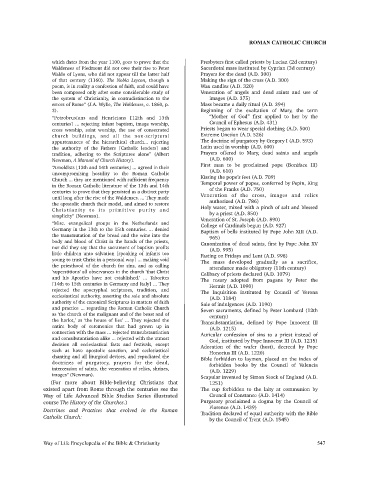Page 547 - Way of Life Encyclopedia of the Bible Christianity. Based on the King James Bible
P. 547
ROMAN CATHOLIC CHURCH
which dates from the year 1100, goes to prove that the Presbyters first called priests by Lucian (2d century)
Waldenses of Piedmont did not owe their rise to Peter Sacerdotal mass instituted by Cyprian (3d century)
Waldo of Lyons, who did not appear till the latter half Prayers for the dead (A.D. 300)
of that century (1160). The Nobla Leycon, though a Making the sign of the cross (A.D. 300)
poem, is in reality a confession of faith, and could have Wax candles (A.D. 320)
been composed only after some considerable study of Veneration of angels and dead saints and use of
the system of Christianity, in contradistinction to the images (A.D. 375)
errors of Rome“ (J.A. Wylie, The Waldenses, c. 1860, p. Mass became a daily ritual (A.D. 394)
3). Beginning of the exaltation of Mary, the term
“Petrobrusians and Henricians [12th and 13th “Mother of God” first applied to her by the
centuries] ... rejecting infant baptism, image worship, Council of Ephesus (A.D. 431)
cross worship, saint worship, the use of consecrated Priests began to wear special clothing (A.D. 500)
church buildings, and all the non-scriptural Extreme Unction (A.D. 526)
appurtenances of the hierarchical church... rejecting The doctrine of purgatory by Gregory I (A.D. 593)
the authority of the Fathers [Catholic leaders] and Latin used in worship (A.D. 600)
tradition, adhering to the Scriptures alone” (Albert Prayers offered to Mary, dead saints and angels
Newman, A Manual of Church History). (A.D. 600)
“Arnoldists [13th and 14th centuries] ... agreed in their First man to be proclaimed pope (Boniface III)
uncompromising hostility to the Roman Catholic (A.D. 610)
Church ... they are mentioned with sufficient frequency Kissing the pope’s feet (A.D. 709)
in the Roman Catholic literature of the 13th and 14th Temporal power of popes, conferred by Pepin, King
centuries to prove that they persisted as a distinct party of the Franks (A.D. 750)
until long after the rise of the Waldenses. ... They made Veneration of the cross, images and relics
the apostolic church their model, and aimed to restore authorized (A.D. 786)
C h r i s t i a n i t y t o i t s p r i m i t i v e p u r i t y a n d Holy water, mixed with a pinch of salt and blessed
by a priest (A.D. 850)
simplicity” (Newman). Veneration of St. Joseph (A.D. 890)
“Misc. evangelical groups in the Netherlands and College of Cardinals begun (A.D. 927)
Germany in the 13th to the 15th centuries. ... denied Baptism of bells instituted by Pope John XIII (A.D.
the transmutation of the bread and the wine into the 965)
body and blood of Christ in the hands of the priests, Canonization of dead saints, first by Pope John XV
nor did they say that the sacrament of baptism profits (A.D. 995)
little children unto salvation [speaking of infants too Fasting on Fridays and Lent (A.D. 998)
young to trust Christ in a personal way] ... making void The mass developed gradually as a sacrifice,
the priesthood of the church for sins, and as calling attendance made obligatory (11th century)
‘superstitions’ all observances in the church ‘that Christ Celibacy of priests declared (A.D. 1079)
and his Apostles have not established.’ ... Taborites The rosary adopted from pagans by Peter the
[14th to 15th centuries in Germany and Italy] ... They Hermit (A.D. 1090)
rejected the apocryphal scriptures, tradition, and The Inquisition instituted by Council of Verona
ecclesiastical authority, asserting the sole and absolute (A.D. 1184)
authority of the canonical Scriptures in matters of faith Sale of indulgences (A.D. 1190)
and practice ... regarding the Roman Catholic Church Seven sacraments, defined by Peter Lombard (12th
as ‘the church of the malignant and of the beast and of century)
the harlot,’ as ‘the house of lies’ ... They rejected the Transubstantiation, defined by Pope Innocent III
entire body of ceremonies that had grown up in (A.D. 1215)
connection with the mass ... rejected transubstantiation Auricular confession of sins to a priest instead of
and consubstantiation alike ... rejected with the utmost God, instituted by Pope Innocent III (A.D. 1215)
decision all ecclesiastical fasts and festivals, except Adoration of the wafer (host), decreed by Pope
such as have apostolic sanction, and ecclesiastical Honorius III (A.D. 1220)
chanting and all liturgical devices, and repudiated the Bible forbidden to laymen, placed on the index of
doctrines of purgatory, prayers for the dead, forbidden books by the Council of Valencia
intercession of saints, the veneration of relics, shrines, (A.D. 1229)
images” (Newman). Scapular invented by Simon Stock of England (A.D.
(For more about Bible-believing Christians that 1251)
existed apart from Rome through the centuries see the The cup forbidden to the laity at communion by
Way of Life Advanced Bible Studies Series illustrated Council of Constance (A.D. 1414)
course The History of the Churches.) Purgatory proclaimed a dogma by the Council of
Doctrines and Practices that evolved in the Roman Florence (A.D. 1439)
Catholic Church: Tradition declared of equal authority with the Bible
by the Council of Trent (A.D. 1545)
Way of Life Encyclopedia of the Bible & Christianity 547

